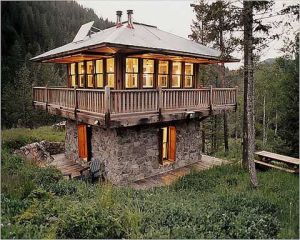 There is always a lot of discussion in the prepper community about whether you should bug out (leaving home) to a remote location or shelter in place (staying home with your family). Bugging out has certain advantages only under special conditions that deserve some consideration.
There is always a lot of discussion in the prepper community about whether you should bug out (leaving home) to a remote location or shelter in place (staying home with your family). Bugging out has certain advantages only under special conditions that deserve some consideration.
Bug Out Considerations
- Do you have a prepared location that is safer than where you live?
- Can you easily get to your prepared location?
- Is your remote location secure and safe?
- Is your remote location fully stocked with supplies?
- Will these supplies last longer than your home?
- Do you plan of pre-staging supplies? Consider the mass and weight of the items you need to bring with you. Food storage is heavy and ammunition is far heavier.
- Is the disaster regional, national or global?
Additional Bug Out Considerations
Your remote location will need to be safer than your current location. Is it hard to find? If found, is it easier to defend than your current location? Just because you live in an urban location does not mean that a rural destination is safer.
You must be able to be travel to your remote location on less than a tank of gas. Travel time must be a consideration. This is especially true if roads are blocked with traffic or you have weather delays. Even then, your remote location needs to be remote enough to provide a measure of distance between you and the danger. Bugging out to a remote location that is 15 – 30 miles away may be helpful in a WROL situation but is pretty worthless for a hurricane.
A bug out bag is designed to have 3 -5 days worth of supplies and a few clothes so you can reach your bug out location. You are to live out the duration of the disaster at your remote location. This could be an extensive period of time. The bulk of your supplies are to be stored at your remote location.
Is your remote location remote enough to provide you enough distance from the danger? If you are escaping a WROL situation then you should have a remote location in the woods at the end of a series of dirt roads. Your location must be defensible. Here are some considerations you should plan for:
- Are you escaping a hurricane? You are going to need a much greater distance to put between you and the path of the storm.
- If the disaster is a regional one, how long do you expect it to last and how severe is it going to be?
- Is the emergency a national or global disaster are you really going to be any better bugging out? You may actually be better staying at home and riding it out.
- For us, we do not have a remote location nor do we plan to establish one. We have designed our home to be our place to ride out any disaster.
Shelter In Place Considerations
Staying home may be your best option. You have to decide for yourself but there are some considerations that may help you make up your mind.
- Do you own property that you could use as a bug out location?
- Do you have the finances to set up a 2nd home that is defensible and fully stocked?
- Can you reach your remote location quickly and in safety?
- Is your health good enough that you could reach your remote location if you were stranded short of your destination?
- How far can you hike carrying weight?
- Is the disaster local, regional, national or global?
 Additional Shelter In Place Considerations
Additional Shelter In Place Considerations
In order to create your bug out location you are going to have to own property and then have the finances to build and stock your remote shelter. Then you are going to have to be very certain that your remote location will be there when you get there. If discovered by others they could take over or steal your supplies even before you arrive.
For us, it was the health question that made our decision. We entered a 5K marathon an only walked it. We finished but the way we felt made it obvious that we could not walk too far and this was without a pack or supplies. Staying home was the obvious choice for us.
This decision then allowed us to focus our efforts in one location and create a plan that did not include leaving or transporting supplies between locations.
WROL Considerations
In a true WROL (Without Rule Of Law) situation are you really going to want to be transporting supplies? How big of a target are your going to be with a truck full of supplies or a vehicle pulling a trailer?
This last statement is huge. In a WROL situation marauders, gangs or even lone wolves are going to be looking for easy prey. Walking with a pack will make you a target for someone looking for supplies.
In a WROL situation stage your yard to make it appear that you house has been ransacked. To camouflage your home place debris in the yard, furniture and even trash. These will make your house appear that it has already been gone through. Leave your lights off at night to give the appearance that no one lives there. Do what you can do to eliminate the appearance that anyone is home or that you have anything worth stealing.
How long do you expect the emergency to last? If it is a regional, national or global emergency you probably will not be any better off leaving. You may even be in more danger away from home.
What if You Have to Leave?
There m ay come a disaster that will bring almost certain death if you stay. Emergencies such as wildfires, category 5 hurricanes, flooding or if your primary home is destroyed are all good reasons to leave your home or bug out.
ay come a disaster that will bring almost certain death if you stay. Emergencies such as wildfires, category 5 hurricanes, flooding or if your primary home is destroyed are all good reasons to leave your home or bug out.
If something likes these disasters happen forcing you to leave your home you will also have to leave the majority of your supplies. You simply cannot bring you entire stock of supplies.
Have a plan to load and leave within a very short period of time. Let’s say you have 15 minutes. Your plan needs to be a list of the most important items as shelter, food, weapons, clothes and medical supplies. This will also include prescriptions and other essential medical supplies. Watch this video to learn more.
Practice loading your supplies into you vehicle. Make adjustments to your plan based on how much room you have in your vehicle. Use every available space in your vehicle. Remember to keep the supplies you will need immediately easy to get to.